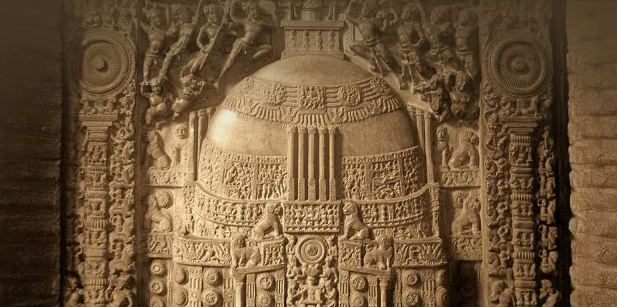Amaravathi: The Rise and Fall of One of the Greatest Buddhist Sites (GS Paper 1, History)

Introduction
- Amaravathi, an ancient site in Andhra Pradesh, India, once stood as a major center of Buddhist art and culture.
- Today, it is remembered both for its historical significance and for the tragic loss of its cultural heritage due to various factors over time.
- The recent announcement by the Union Finance Ministry of financial support of Rs. 15,000 crore for the development of Amaravati, the new capital of Andhra Pradesh, highlights the ongoing relevance of the Amaravathi site and its historical legacy.
- This discussion delves into the rise and fall of Amaravathi, tracing its journey from a prominent Buddhist hub to its current state.
Discovery and Early Destruction
- The initial discovery of Amaravathi's ruins can be traced back to the late 1700s.
- Raja Vessareddy Nayudu, in Dhanyakatakam village, first uncovered these ancient remains.
- Unfortunately, the limestone pillars and panels were repurposed for construction, leading to the destruction of significant parts of the site.
- This pattern of destruction continued, exacerbating the loss until 1816 when Colonel Colin Mackenzie, the first surveyor general of India, conducted a survey of the site.
- His work, while rediscovering the Amaravathi stupa, also led to further damage.
Colonial Era and Rediscovery
- The 19th century saw increased interest in Amaravathi, primarily due to colonial surveys.
- Colonel Mackenzie’s efforts in 1816 marked a period of rediscovery but also led to the removal and relocation of numerous sculptures.
- Many of these artifacts were sent to various locations, including London, where they faced further deterioration.
- This period of exploration and excavation, though essential for uncovering Amaravathi’s significance, also contributed to the loss of its cultural heritage.
Amaravati as a Modern Capital
- In a nod to its historical roots, the new capital of Andhra Pradesh, named Amaravati in 2015, was established about 20 km from the original Amaravathi site.
- The naming was driven by numerological considerations rather than historical ones.
- The modern Amaravati, while embracing the legacy of its ancient namesake, has its own distinct development trajectory, symbolizing a blend of historical reverence and contemporary growth.
The Rise of Buddhism in Andhra
- Buddhism, which originated in Magadh in the 5th century BCE, spread to Andhra Pradesh through trade and cultural exchanges.
- Amaravathi emerged as a significant center for Buddhism before the rise of the Satavahanas.
- Emperor Ashoka's reign (269-232 BCE) under the Mauryan Empire was pivotal in establishing a stupa and monastery at Amaravathi.
- His 3rd-century BCE inscriptions significantly boosted the spread of Buddhism in the region.
- The early urbanization of Andhra Pradesh was closely linked to the growth of Buddhism, with merchants and local practices influencing its spread and development.
Significance of Amaravathi in Buddhism
- Amaravathi became a major center for Mahayana Buddhism, with Acharya Nagarjuna's teachings further spreading the religion across South Asia and beyond.
- The Amaravathi stupa played a crucial role in the development of the Amaravathi school of art, known for its aesthetic sculptures and influence on later Buddhist art in South and Southeast Asia.
- The site remains sacred to many, including prominent figures like the Dalai Lama, who recognize its historical and spiritual significance.
Decline and Modern Challenges
- The decline of Buddhism in Andhra Pradesh can be attributed to the rise of Shaivism and socio-economic changes by the 4th century CE.
- This decline was marked by reduced patronage and competition from other religions.
- The 19th century saw further damage through destruction and looting, with many artifacts being dispersed globally.
- Recent efforts have focused on repatriation, such as Australia's return of a stolen Amaravathi-style sculpture under the 1970 UNESCO Convention.
- However, there remains a lack of systematic provenance research and proactive repatriation efforts in India.
Conclusion
- Amaravathi's journey from a vibrant center of Buddhist art and culture to its current state reflects a complex history of rise, fall, and rediscovery.
- While the site’s cultural heritage has been significantly impacted by destruction and looting, efforts to preserve and honor its legacy continue.
- The recent financial support for the development of Amaravati, coupled with ongoing repatriation efforts, underscores the importance of Amaravathi’s historical and cultural significance.
- As India moves forward, it must continue to balance modernization with the preservation of its rich historical heritage, ensuring that the legacy of Amaravathi is both remembered and respected.


